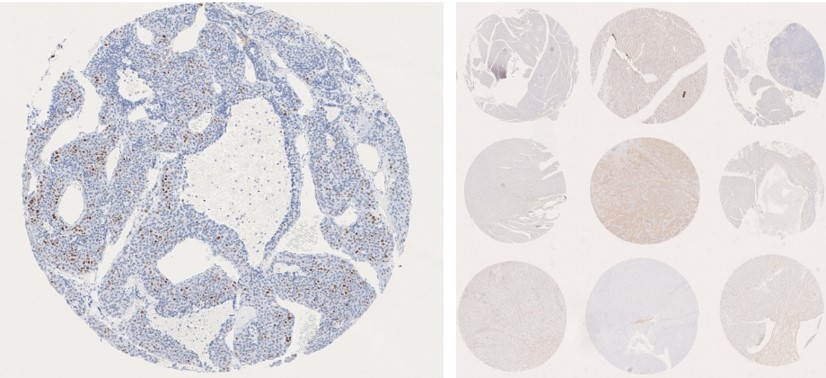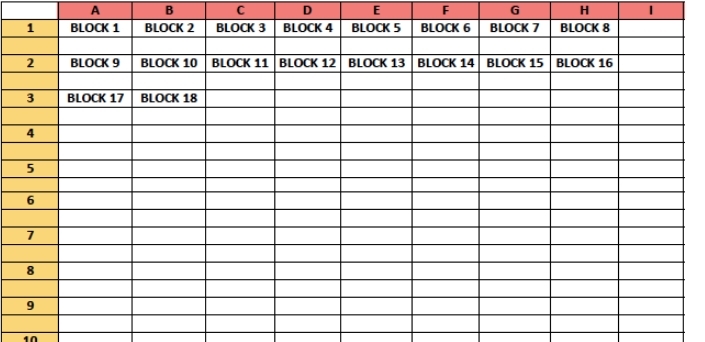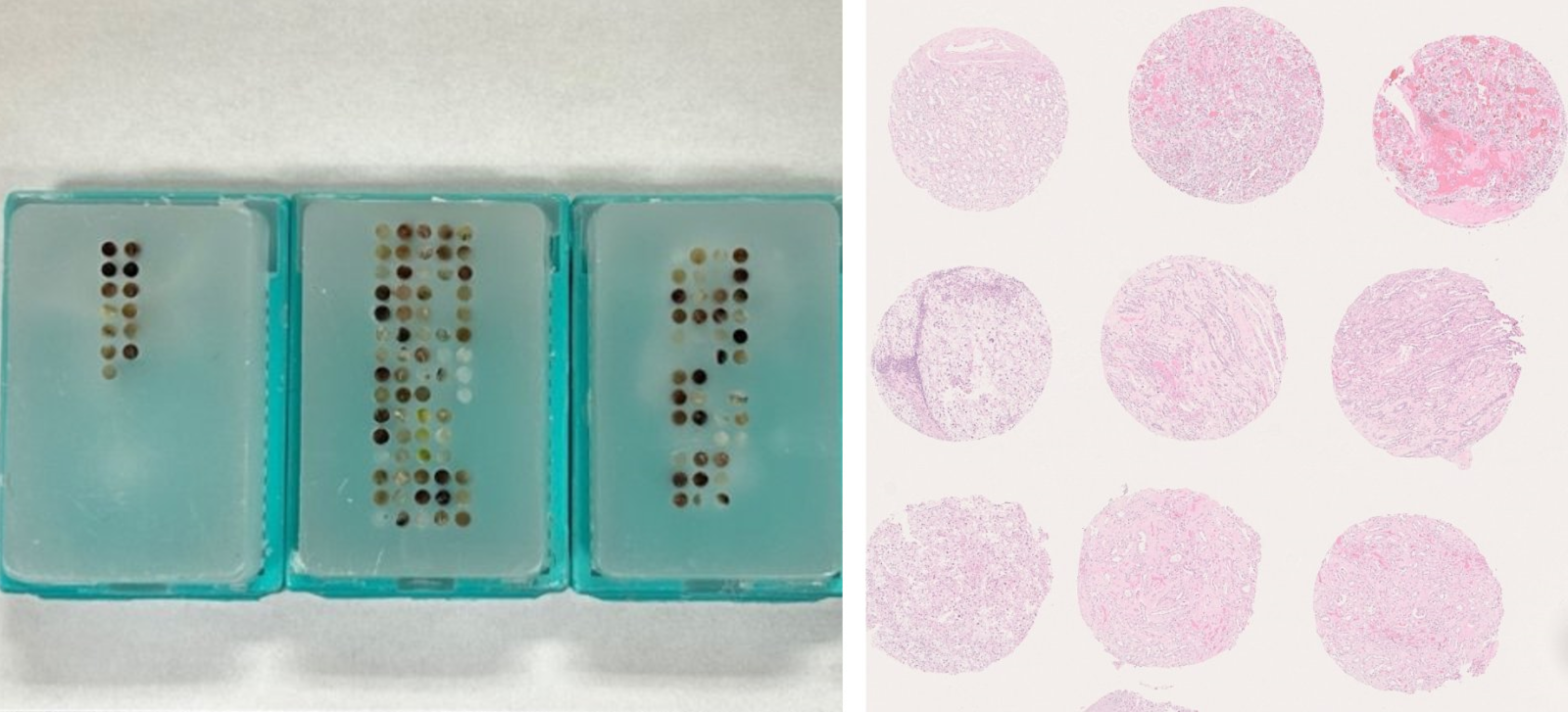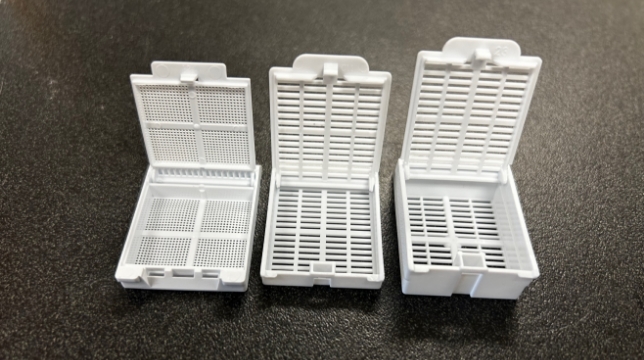
Routine Stain
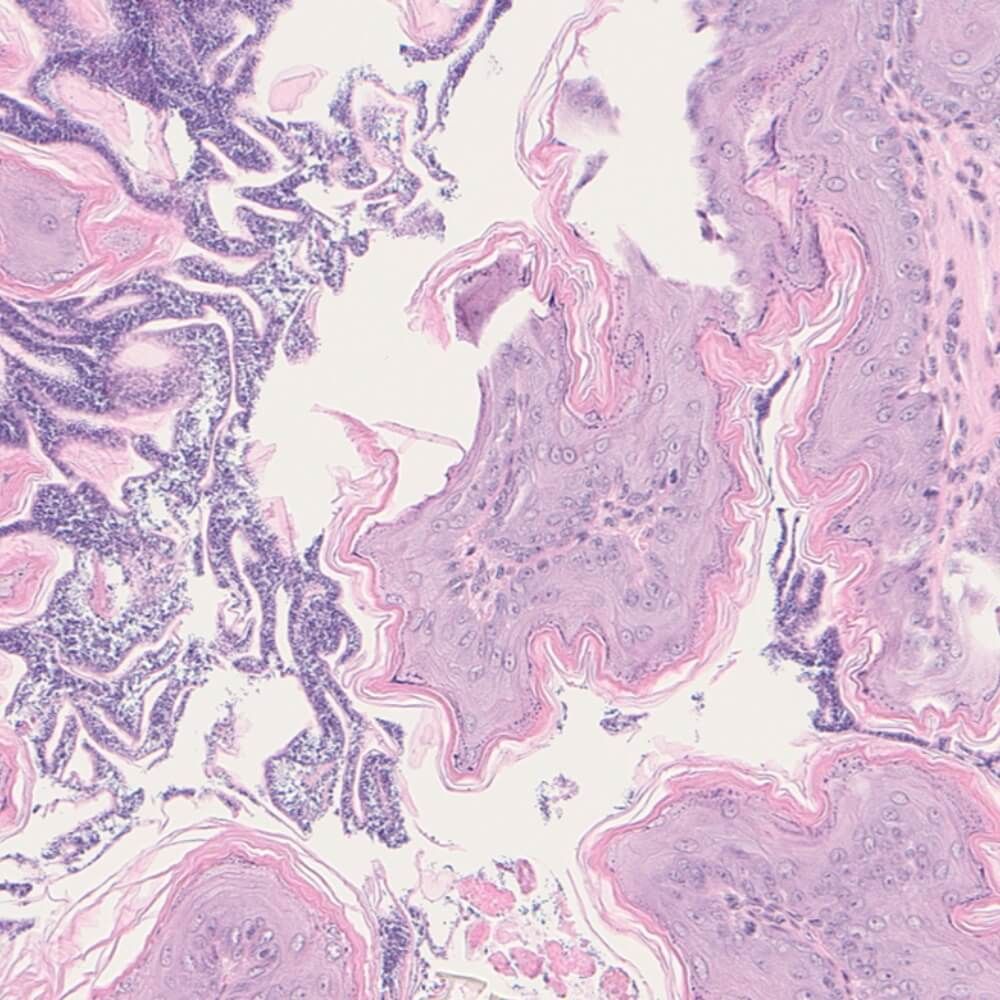
Hematoxylin and Eosin (H&E)
H&E is the most common histological stain. The stain is used to view morphological structures in a section of tissue. This stain can be used on any tissue type, and will highlight nuclear, cytoplasmic, and extracellular matrix features.
Results: Nuclei and ribosome will stain a blue purple. Cytoplasm, collagen and the extracellular matrix will stain red-pink.
Lipid Stain
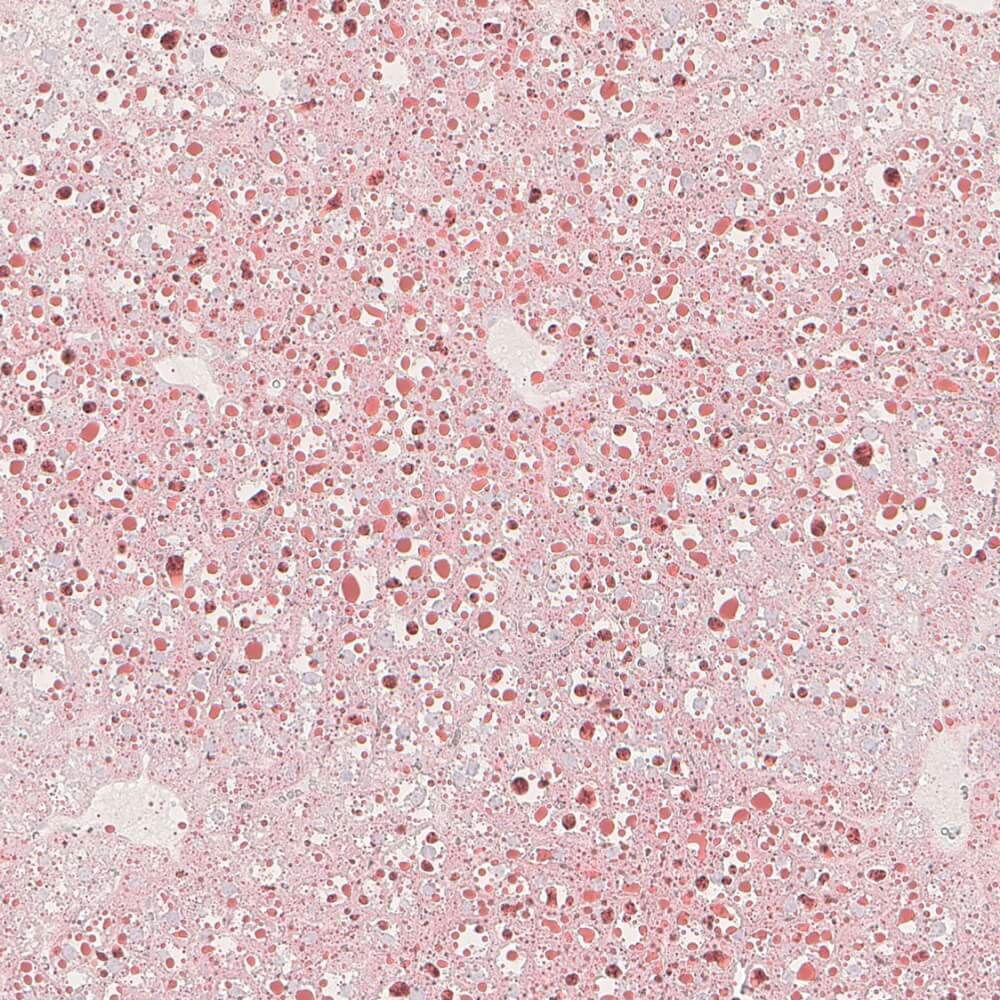
Oil Red O (ORO)
Oil Red O is used to stain lipids, lipid containing vacuoles, triglycerides to assess their morphology. The stain must be used on frozen sections, as paraffin processing dehydrates lipids. Results: The lipids will be stained Red. A counter stain can be used to visualize other structures, such as nuclei, which can be stained blue with hematoxylin.
Connective Tissue Stains
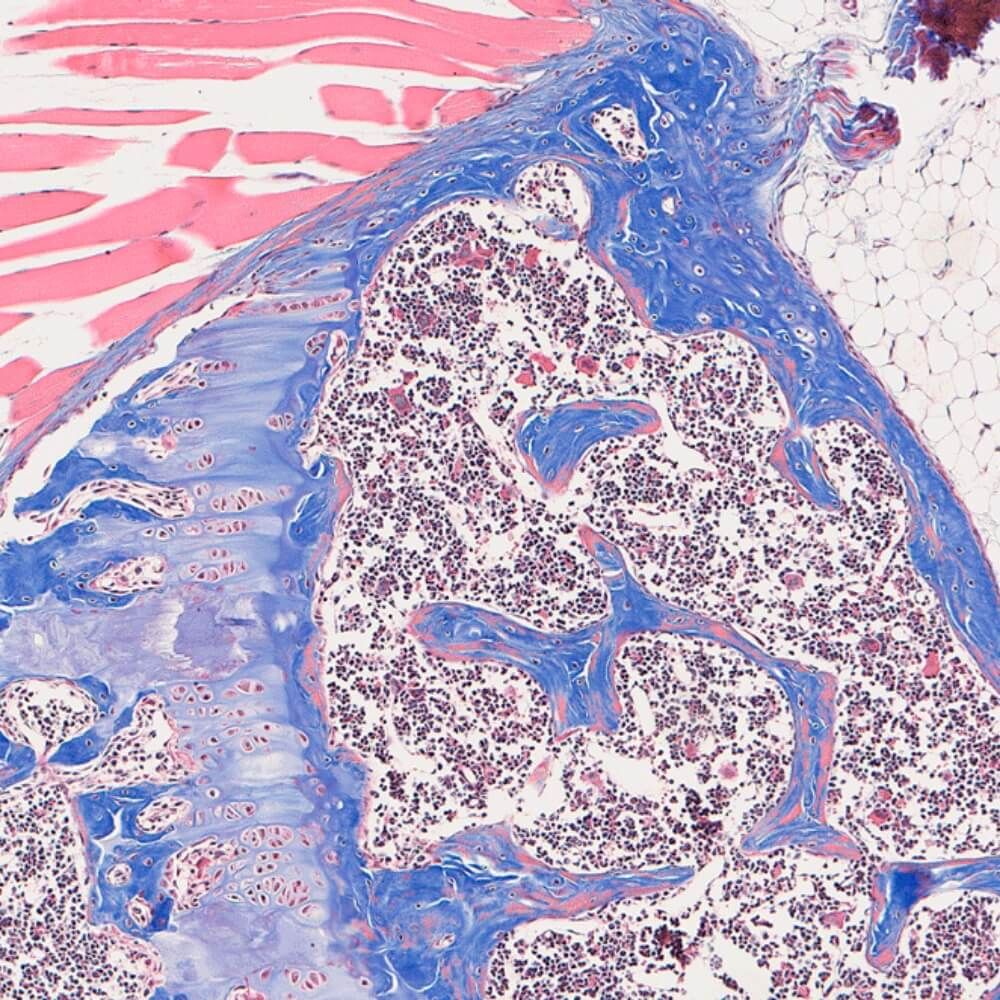
Mason’s Trichrome
Masson’s Trichrome stains connective tissues. It is often used in studying fibrosis, immune deposits and to differentiate between collagen and smooth muscles. It can also be used to assess wound healing. The stain highlights muscles, collagen, nuclei, keratin, and mucins. Results: Will stain nuclei black, muscles, cytoplasm, and keratin red, and stain collagen and mucins blue.
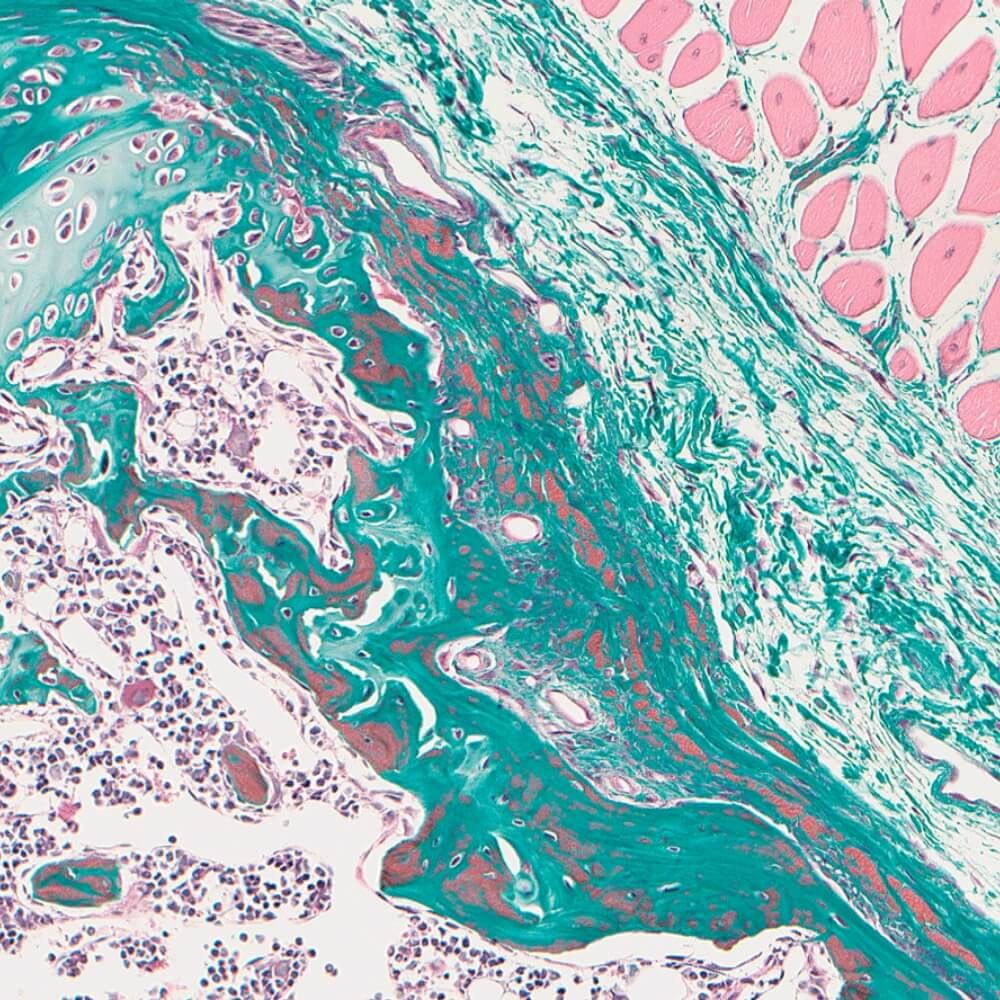
Mason’s Trichrome Light Green
Masson’s Trichrome Light Green is used to differentiate collagen and smooth muscle. This stain is a variant of the regular Masson’s Trichrome, staining collagen fibers green instead of blue. It can be used to detect cirrhosis, muscular, cardiac or kidney pathologies or study tumors in biopsies. Results: Will stain muscle fibers, cytoplasm, and keratin red, nuclei blue-black and collagen and mucin green.
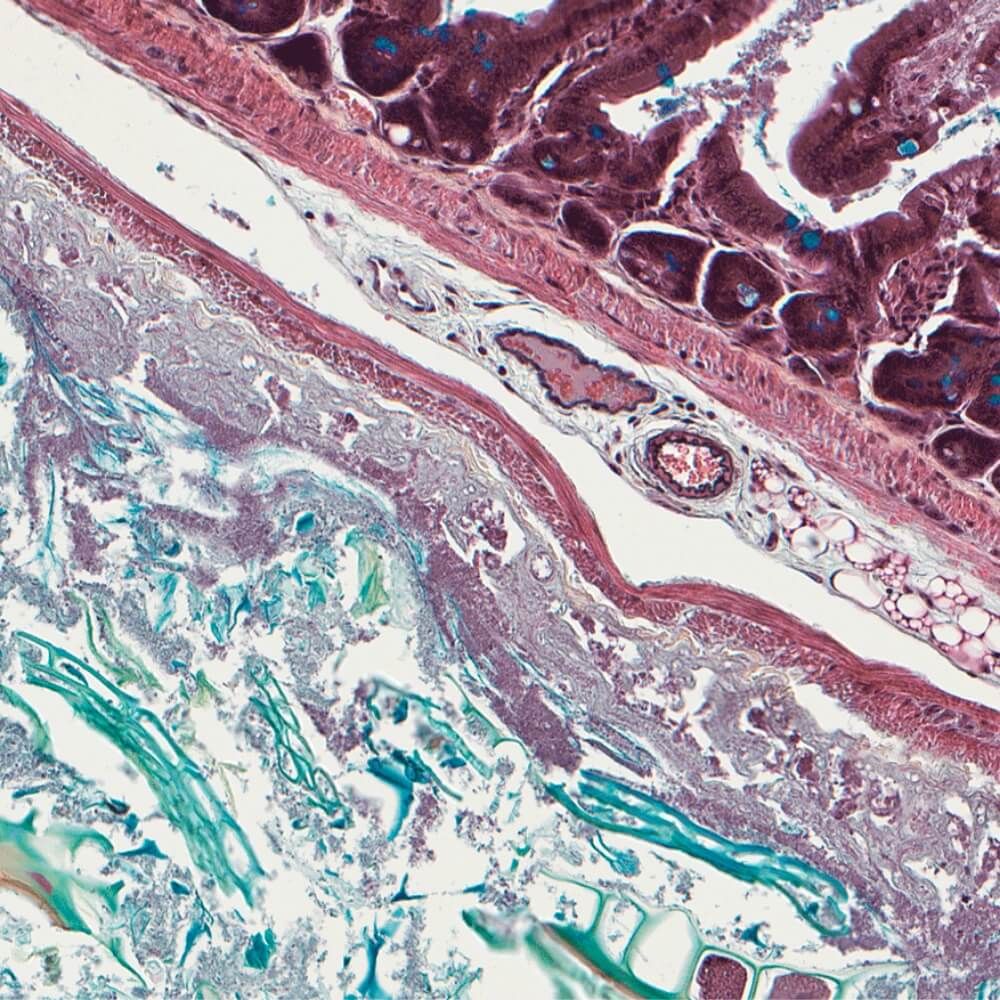
Movat’s Pentachrome
Movat Pentachrome is a complex stain, used to simultaneously stain collagen, reticular fibers, muscle, elastic fibers, and nuclei. It is commonly used to study connective tissues, like lungs, blood vessel and the heart. Results: Mucin will be stained a blue-green, nuclei and elastic fibers black, collagen and reticular fibers yellow and fibrin and muscle red.
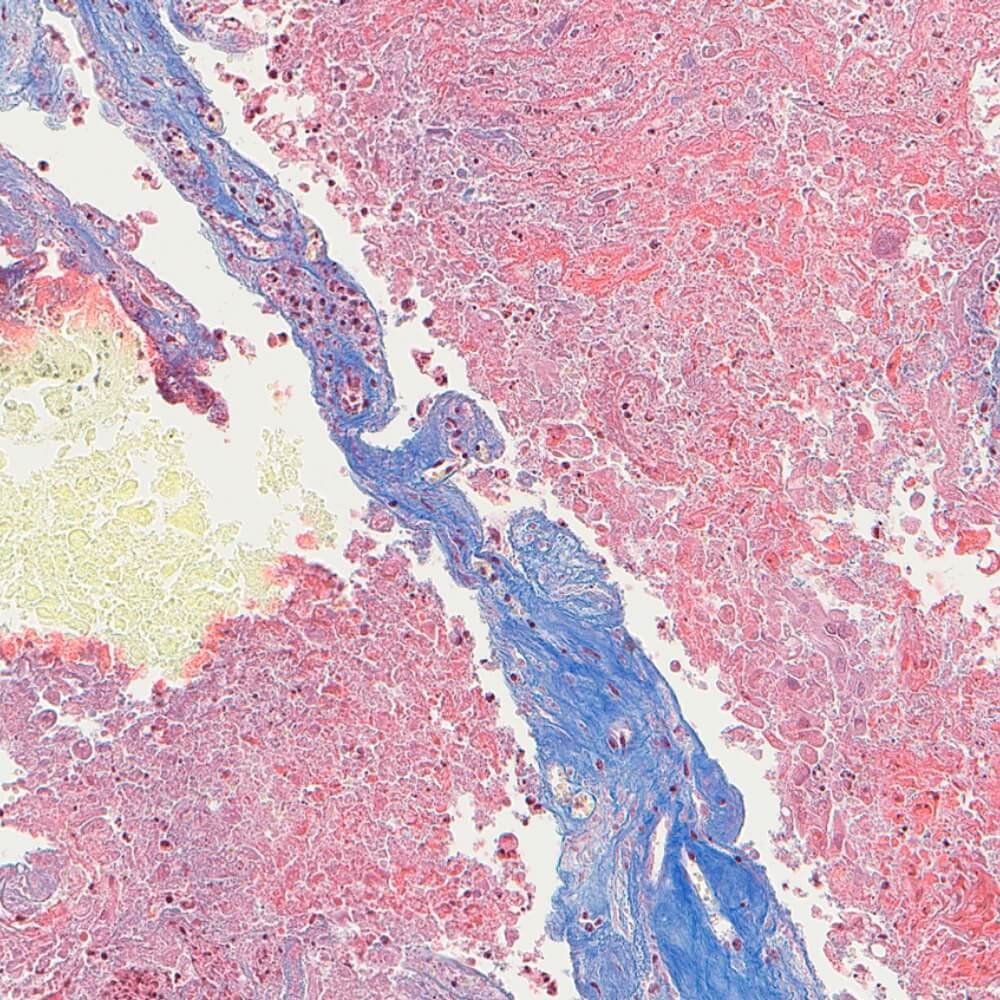
Martius Scarlet Blue
Martius Scarlet Blue is used too stain fibrin. The stain is ideal for differentiating between fresh and mature fibrin. Results: Stains connective tissues blue, fibrin red and fresh fibrin and erythrocytes yellow.
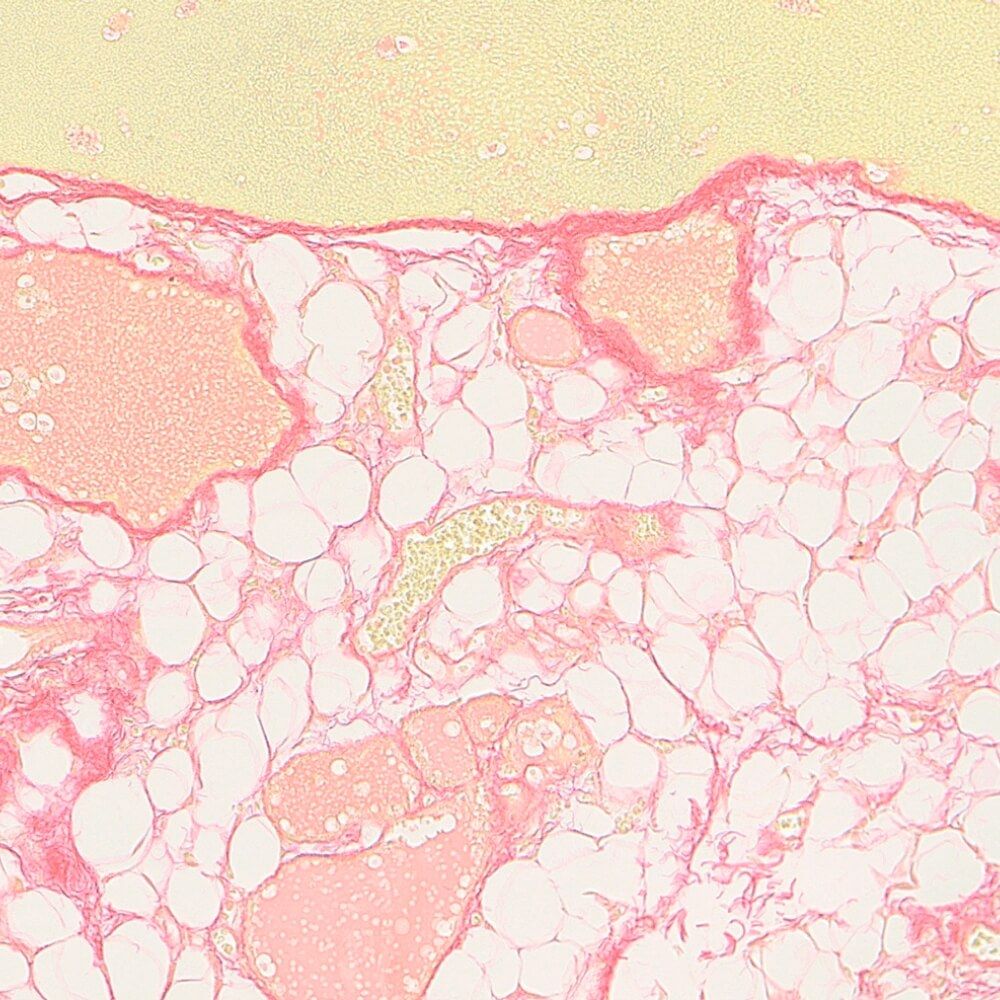
Picosirius Red
Picosirius Red is used to stain collagen, specifically collagen I and III fibers. This technique can be used to visualize fibrosis.
Results: Will stain collagen red and the cytoplasm, nuclei, and muscle fibers yellow.
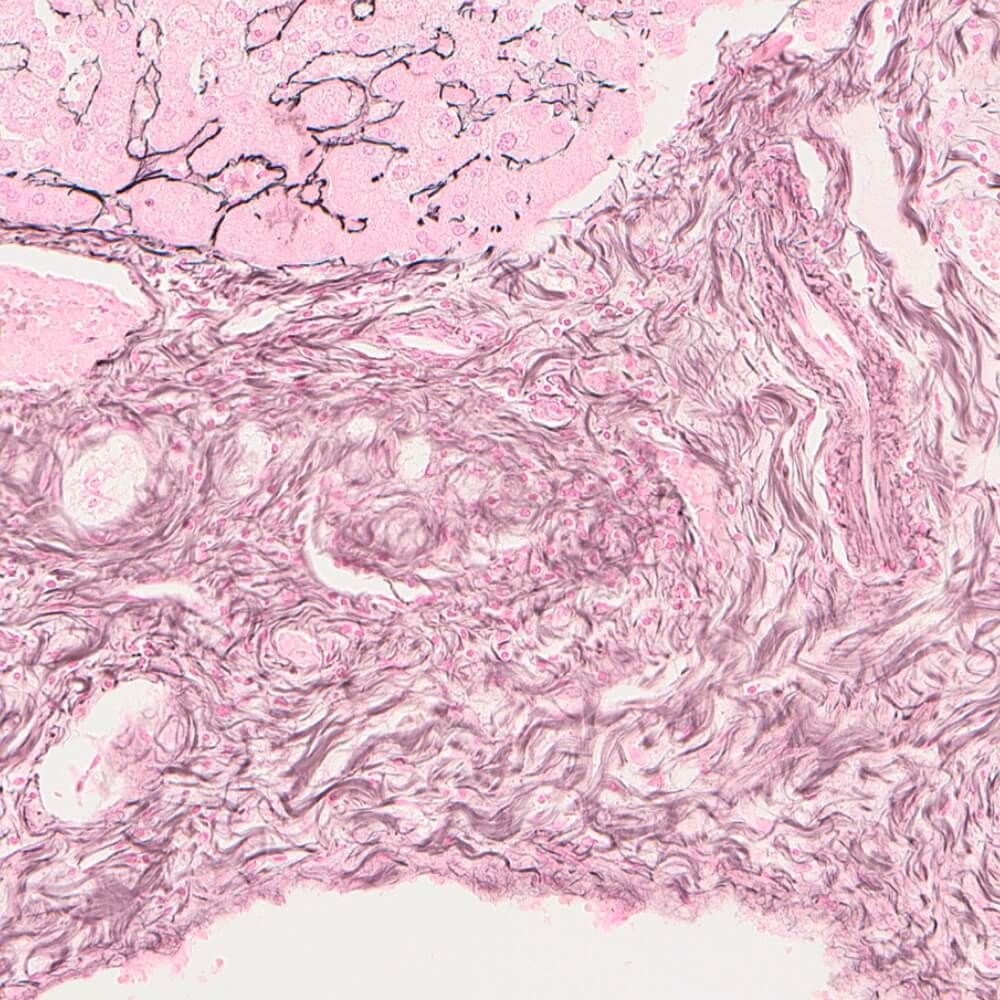
Reticulin
This stain is used to highlight the reticulin fibers of the stroma. Often used in tumors, to test if tissue is necrotic, and in the examination of fibrosis. Reticulin is commonly found in the spleen, liver, and kidneys.
Results: The reticulin fibers will stain black. A counter stain can be used for the nuclei.
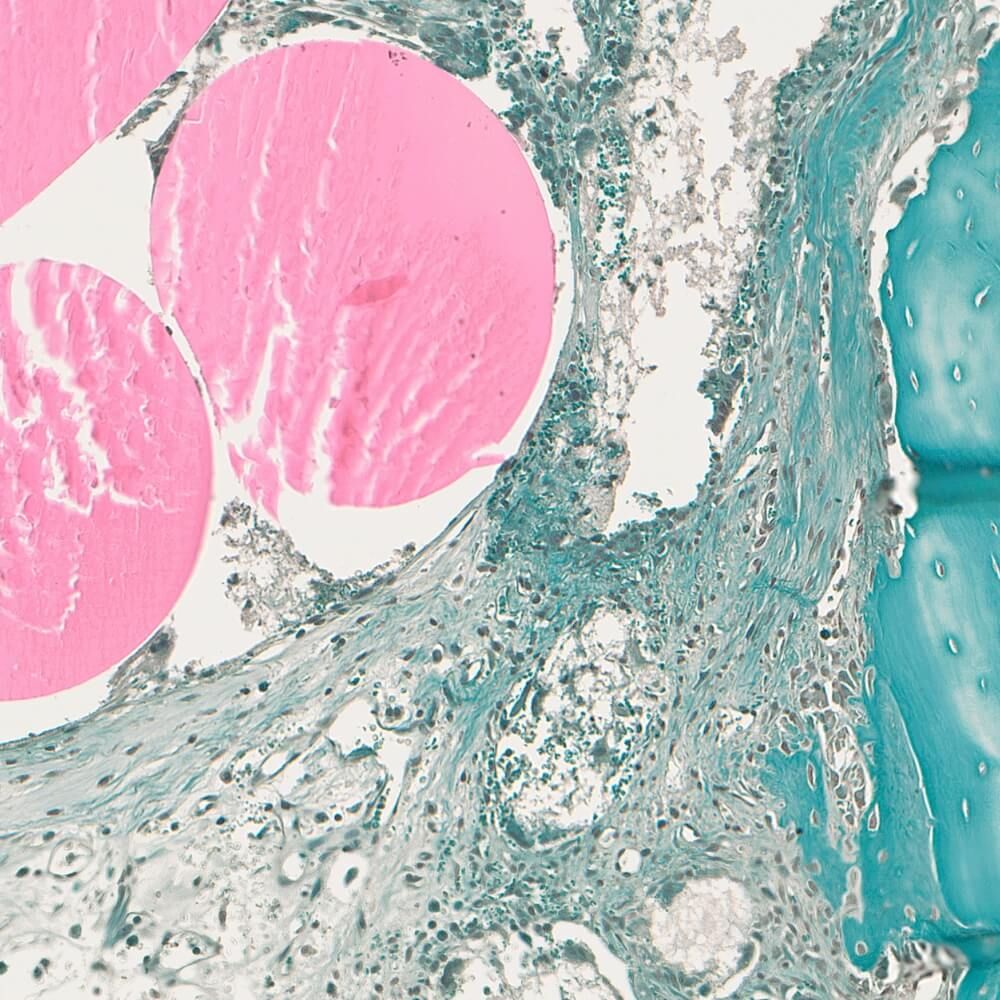
Safranin O
Safranin O is used to stain cartilage, mucin, and mast cell granules.
Results: Will stain cartilage, mucin, mast cell red/orange, cytoplasm, bone, and connective tissue green and nuclei black.
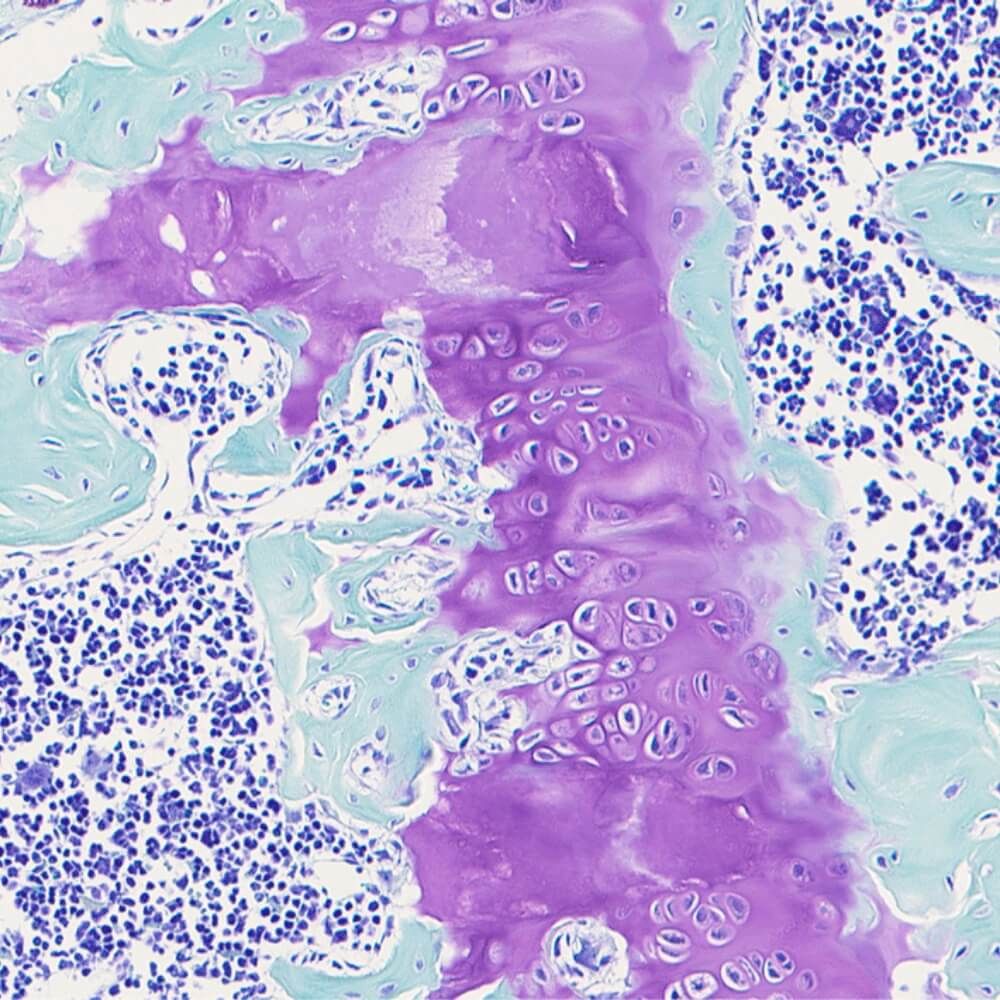
Toluidine Blue
Toluidine Blue will stain acidic tissue components, this can include nucleic acid. Thus, tissues high in DNA and RNA will be stained. It is often used to identify mast cell granules in disease conditions such as cancer and can be used to assess injuries in cells.
Results: Stains nuclei dark blue, and polysaccharides and mast cells violet.
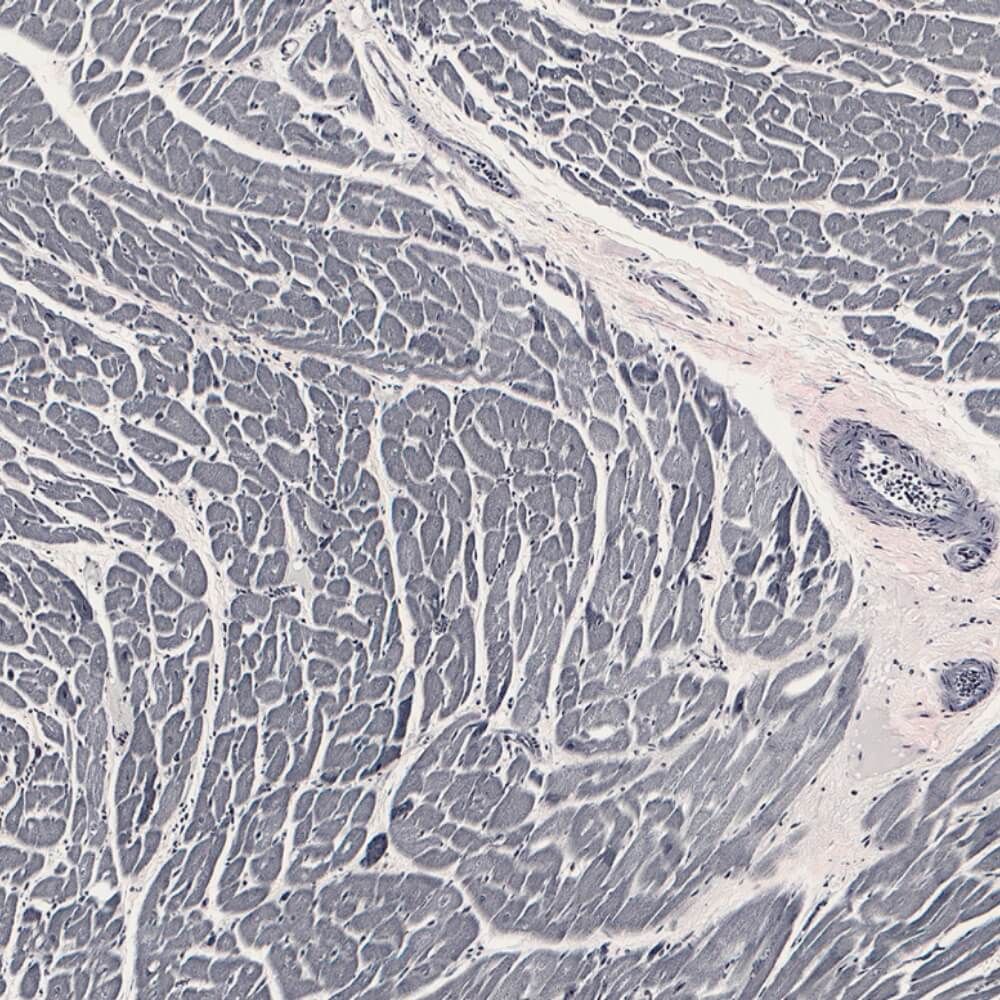
Verhoeff
The Verhoeff stain is used to stain elastic fibers. Can be used to study atrophy of elastic tissues, tumor invasion into vessels and vascular disease.
Results: Will stain elastin black. If a counterstain is desired, one should choose the Verhoeff-van Geison stain instead.
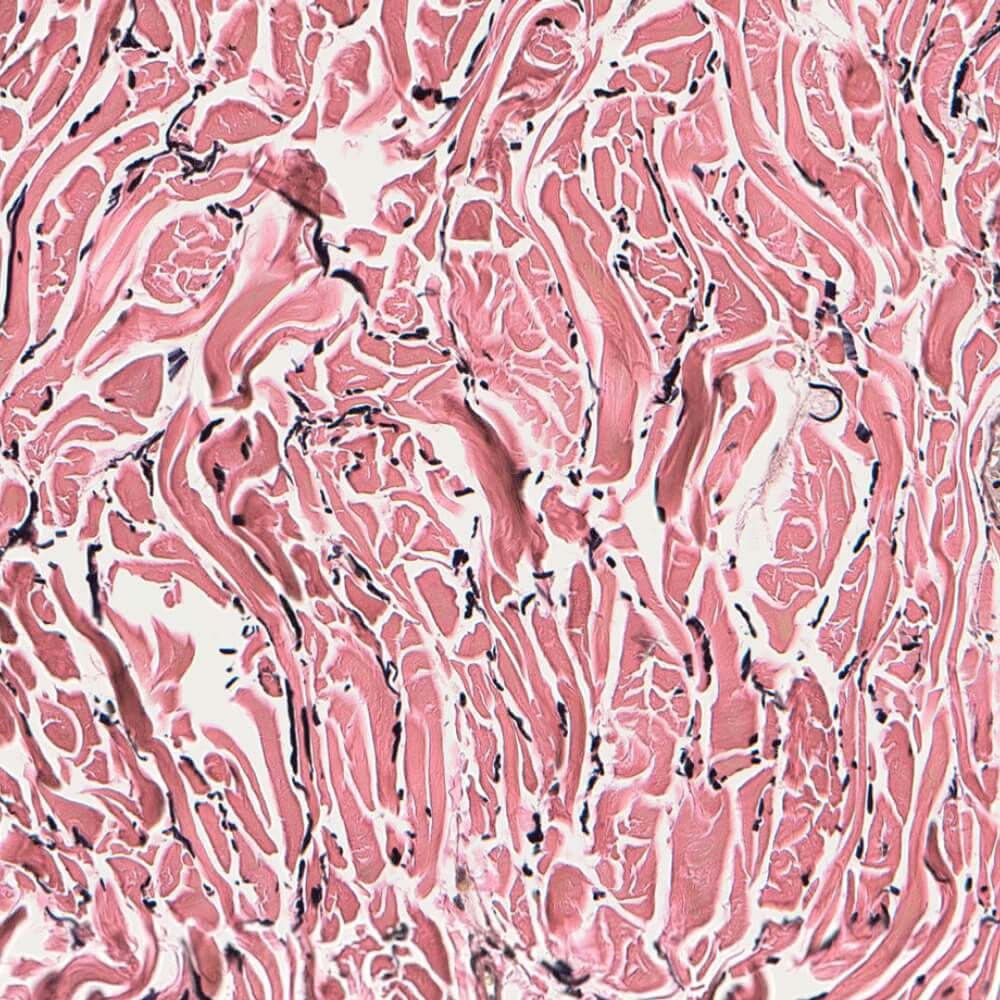
Verhoeff-Van Geison Elastic Stain (VVG)
Used to stain elastic fibers. Can be used in studying atrophy of elastic tissues, tumor invasion into vessels and vascular disease.
Results: Stains collagen red, muscle yellow and elastic fibers black.
Glycogen, Mucin & Carbohydrates Stains
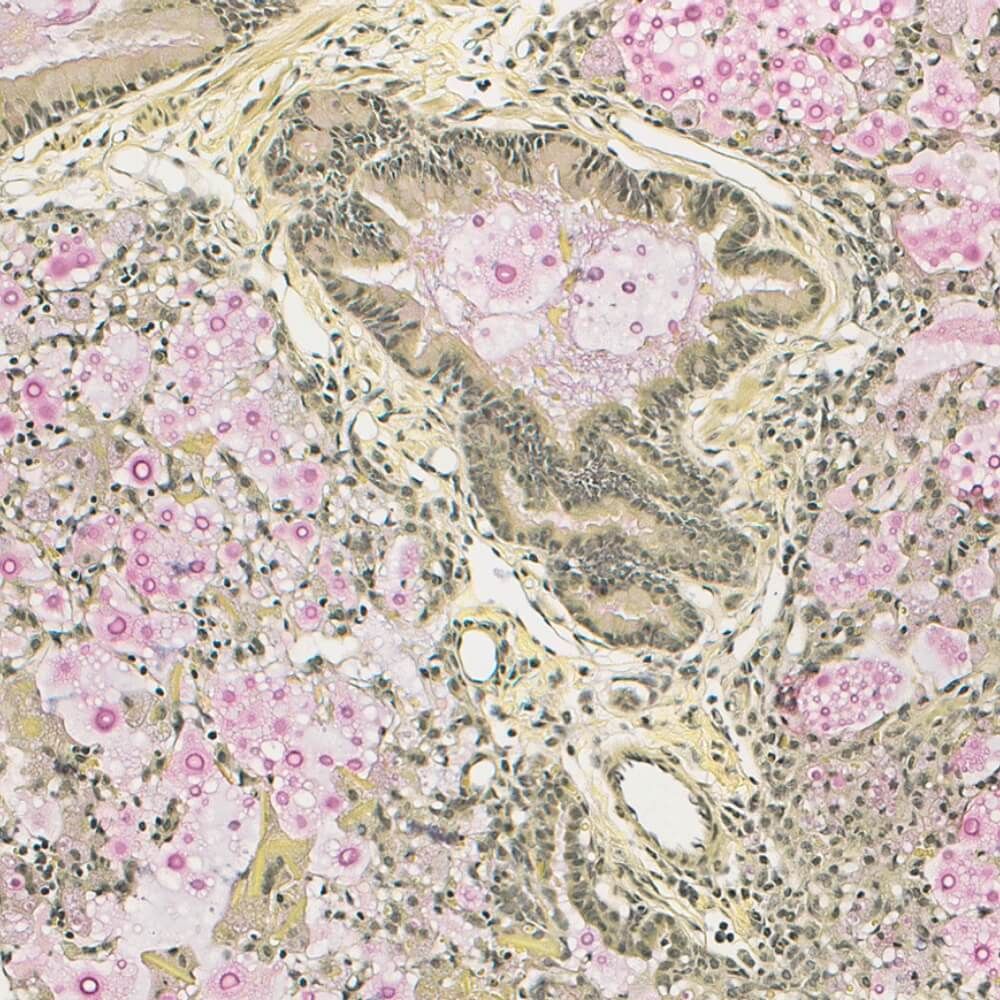
Mucicarmine
Mucicarmine is used to stain mucin, which is secreted by epithelial cells. This technique can also stain the fungus capsule. It can be used to assess inflammation and determining the site of a primary tumor. Additionally, it also stains encapsulated fungi.
Results: Stains mucin a deep red-pink, nuclei black and other tissue yellow.
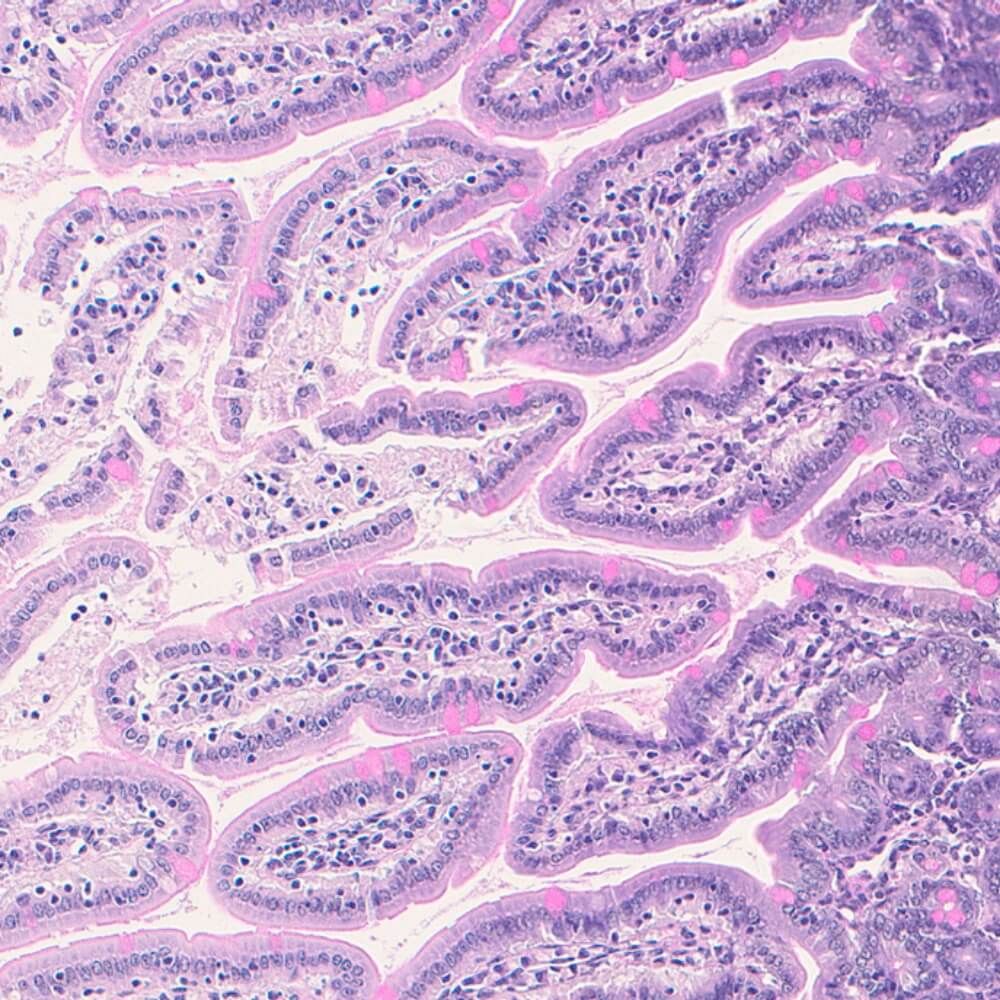
Periodic Acid-Schiff Reagent (PAS)
Primarily used to stain glycogen. Also stains basement membranes, mucoplysaccharids and some mucin. PAS staining can be used in tissues like heart, liver, or muscle. Glycogen may also be present in tumors. The stain can also, identify yeast forms of fungi within tissue samples.
Results: Stains the glycogen, mucin, basement membranes and fungi red-purple and the background blue.
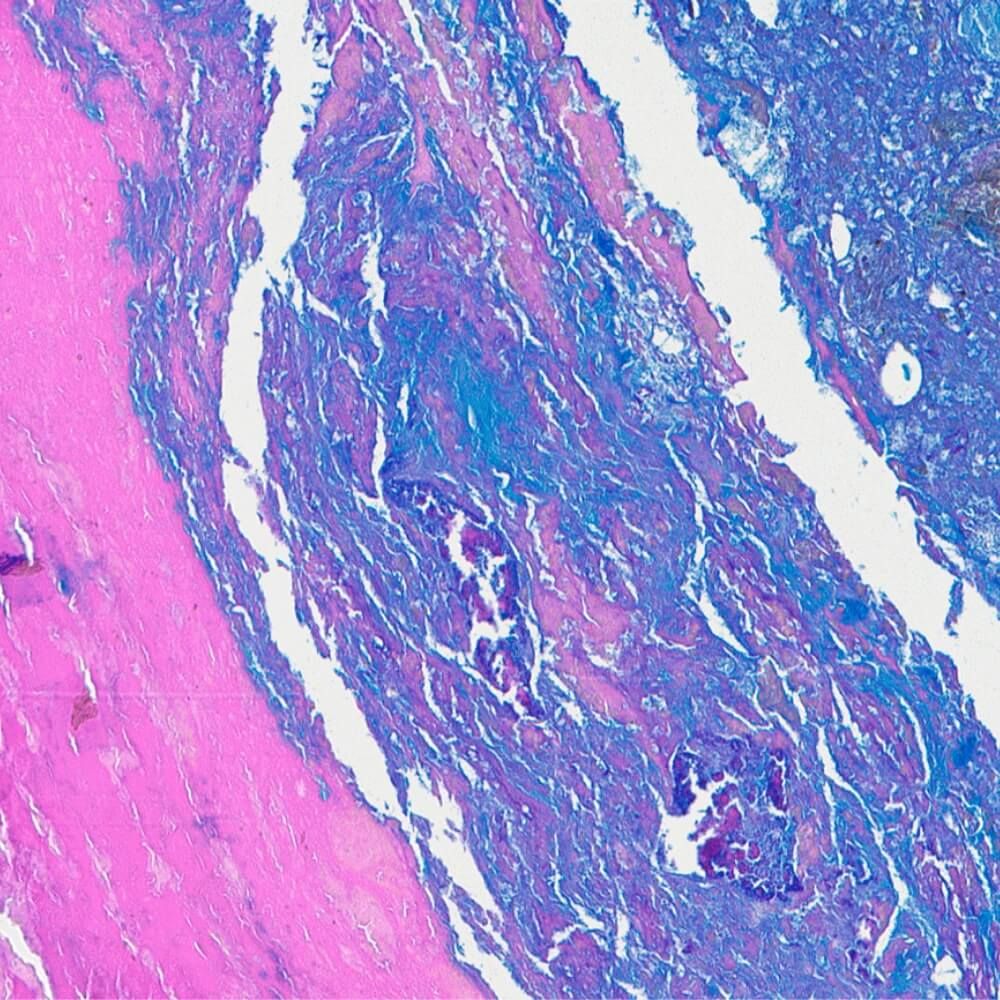
Periodic Acid-Schiff Reagent- Alcian Blue (PAS-AB)
PAS-AB staining is used to differentiate between acidic mucins and neutral mucins.
Results: Will stain acidic mucins a deep blue and neutral mucins magenta. Cells containing both types of mucins may turn a dark purple.
PAS-AB with Hematoxylin
PAS-AB- Hematoxylin staining is used to differentiate between acidic mucins and neutral mucins.
Results: Will stain acidic mucins a blue and neutral mucins magenta. Cells containing both types of mucins may turn a dark purple. Nuclei-stained deep blue.
Alcian Blue
Alcian Blue stains acidic mucins secreted by both epithelial cells and connective tissue. Tissues can be stained at different pH’s including, 2.5 and 1.
Results: Stains acid mucin blue.
Mineral Stains
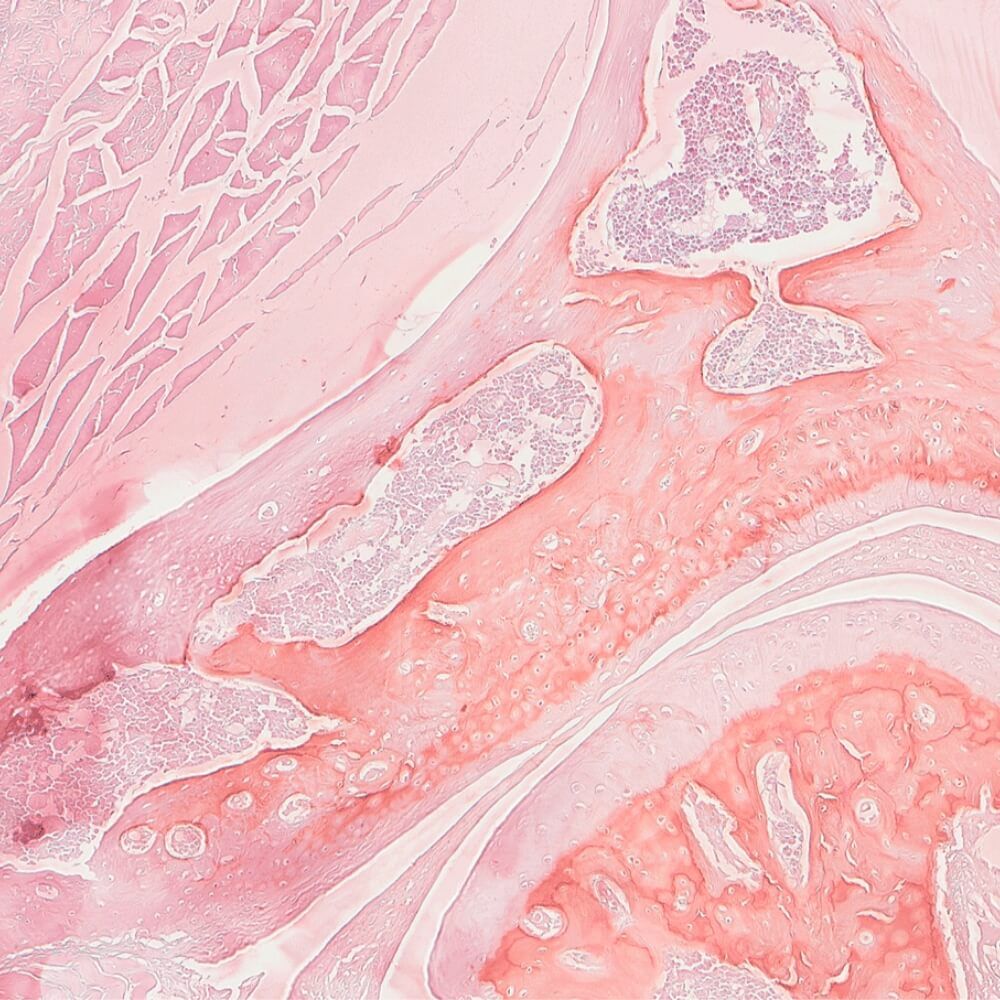
Alizarin Red
Alizarin Red will stain tissues with calcium deposits. Often used to stain tissues in the vascular system, or bones and bone marrow.
Results: Stains calcium red.
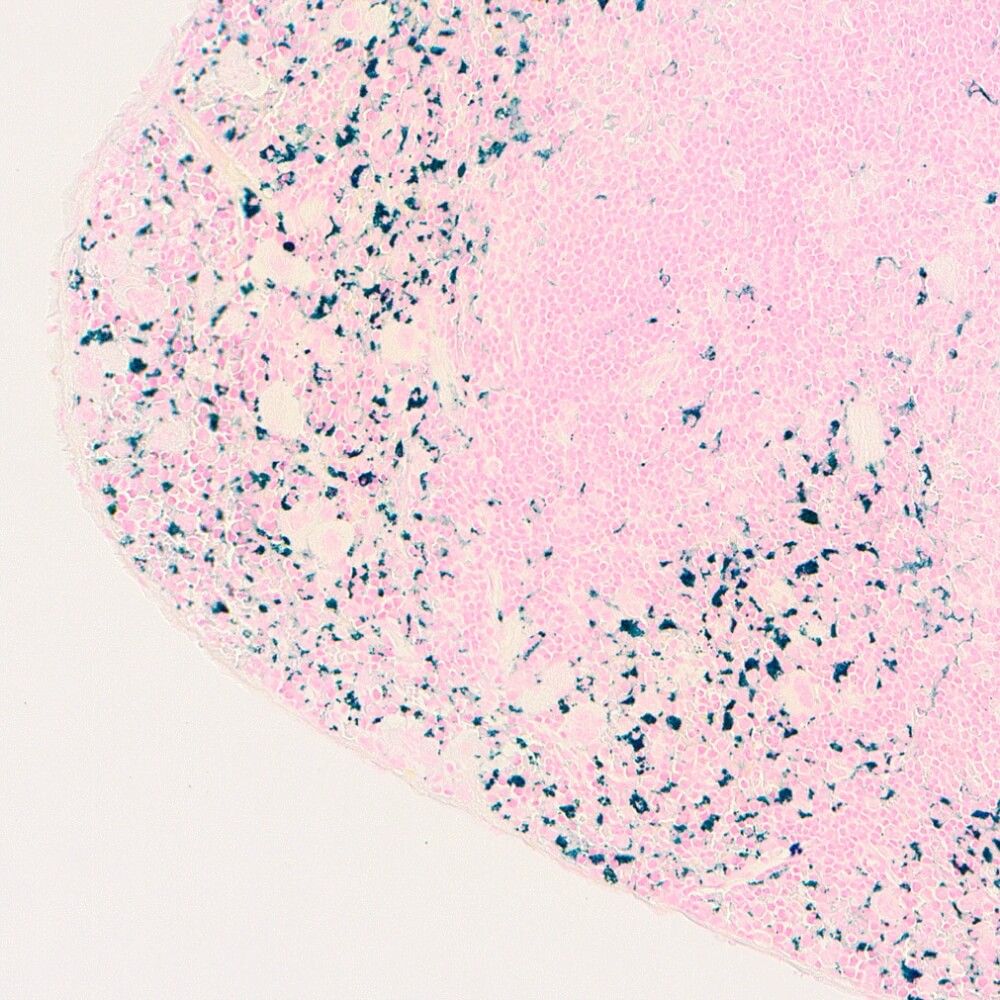
Prussian Blue
Prussian Blue is used to detect iron in tissues. The stain can be used to assess excess iron in tissues such as hemochromatosis or a hemorrhage.
Results: Iron will be stained blue-purple, nuclei and cytoplasm will stain red, and the background will stain pink.
Van Kossa
Van Kossa staining is used to test the presence of calcium deposits. Van Kossa can stain any tissue with calcium deposits. Most common tissues with abnormal calcium include kidneys, blood vessel and joints.
Results: Stains calcium black. Can undergo counter staining to stain the nuclei red and the cytoplasm pink.
Neuronal Stains
Cresyl Violet
Cresyl Violet is used to stain the Nissl substance, or the rough endoplasmic reticulum, found in cytoplasm of neurons. This stain is used in neuronal structures (brains, spinal cord).
Results: Nissl substance and nuclei gain a purple-blue colour.
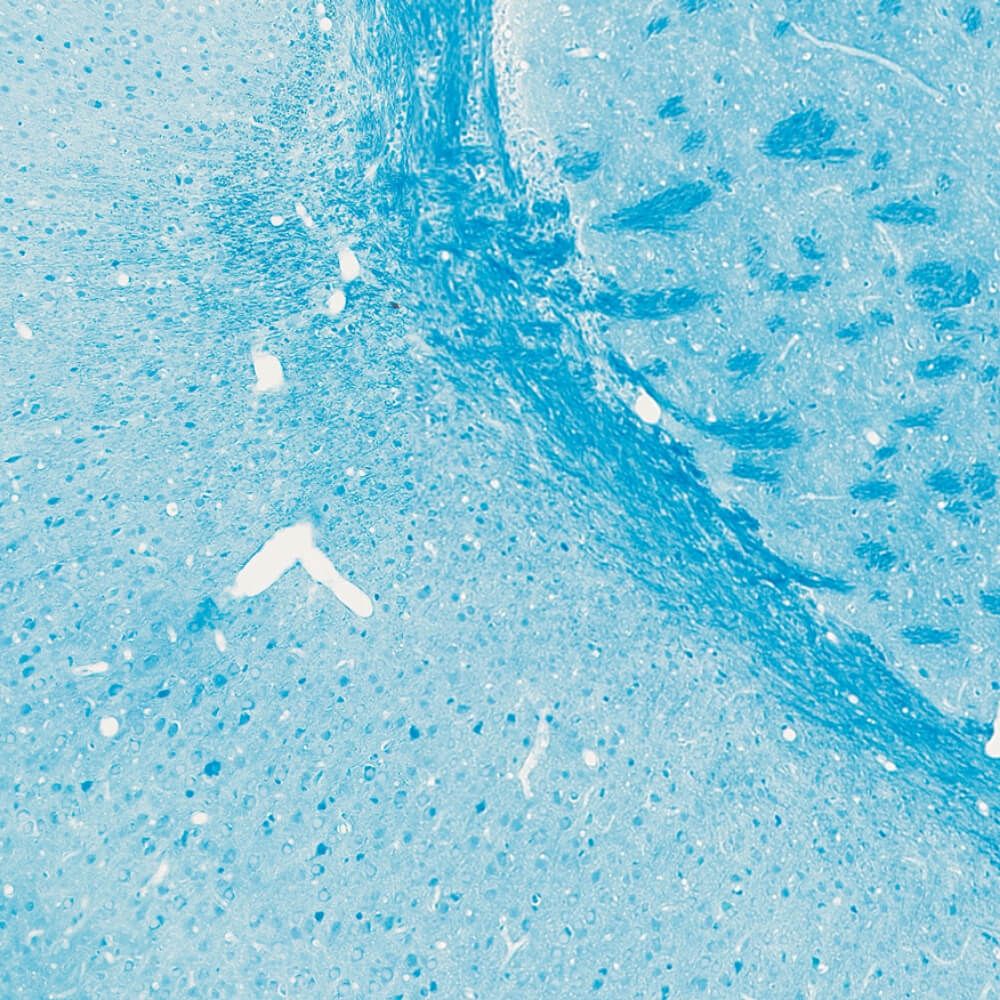
Luxol Fast Blue (LFB)
LFB is used to stain myelin in the nervous system. Commonly used to assess levels of the white matter of the brain.
Results: Will stain myelin/ white matter a blue and the gray matter will become light blue-colourless.
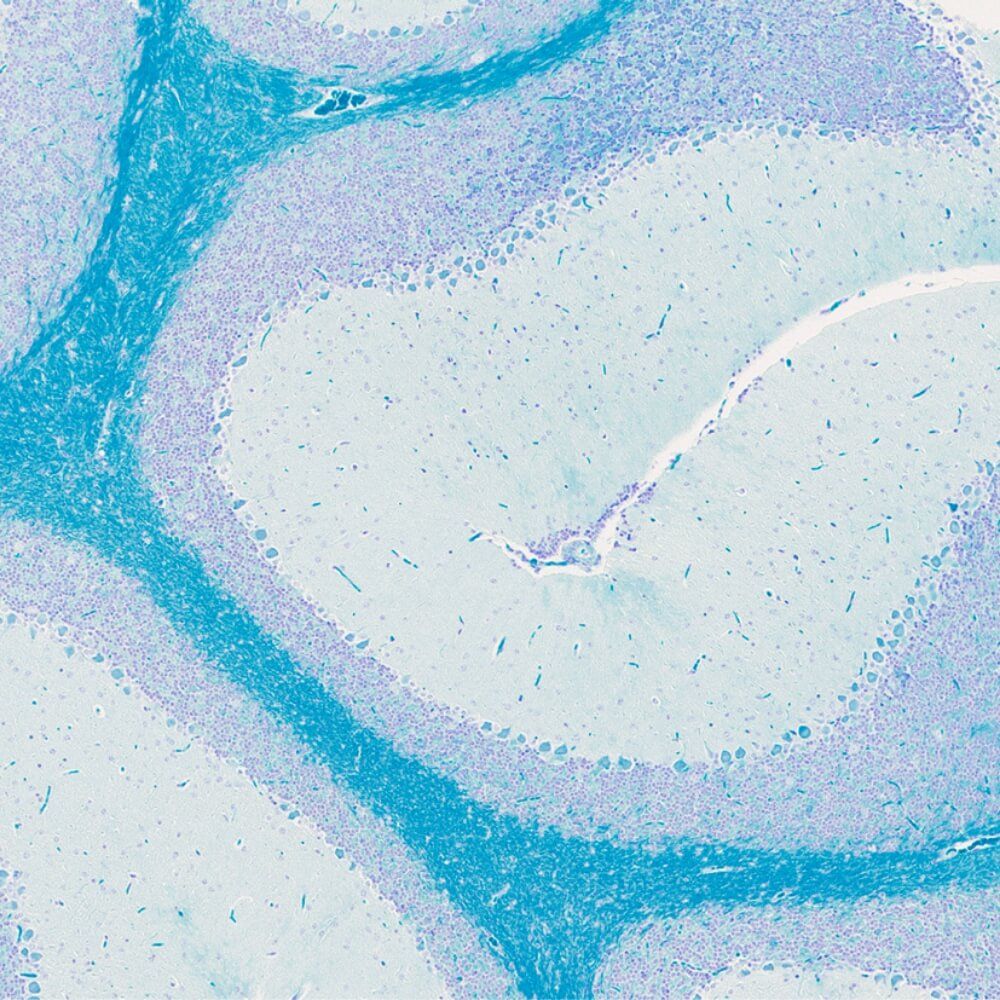
Luxol Fast Blue + Cresyl Violet (LFB-CV)
LFB-CV can be used to stain myelin in the nervous system. Often used to stain the white matter of the brain. The Cresyl Violet acts as a counter stain to stain RNA/ Nissl Substances.
Results: Will stain myelin/ white matter a blue, the gray matter will become light blue-colourless, and RNA/ Nissl substance will become dark blue.
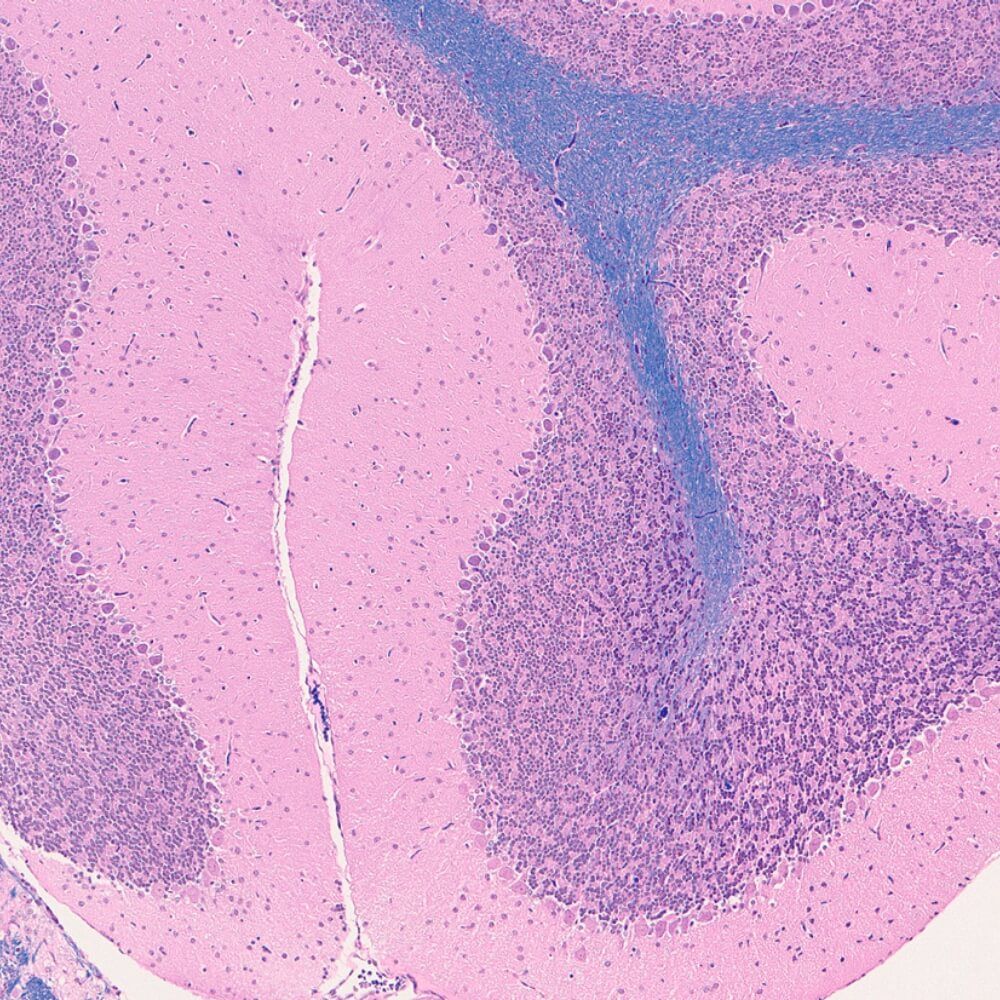
Luxol Fast Blue + Hematoxylin and Eosin (LFB-H&E)
LFB-H&E is used to stain myelin in the nervous system, to assess levels of white matter. The H&E acts as a counter stain to visualize other structures.
Results: Will stain myelin/ white matter a blue, the gray matter and cytoplasm will stain pink to red, and the nuclei will stain dark blue-purple.
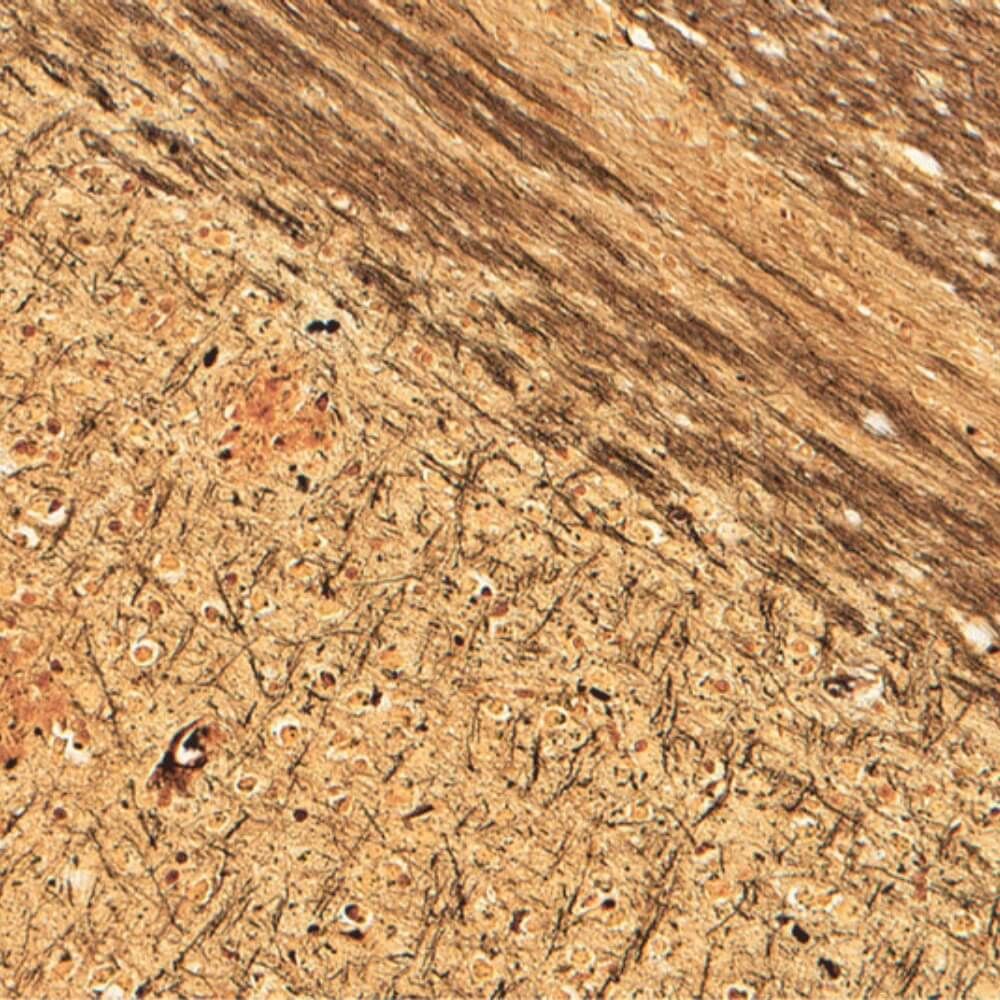
Bielschowsky
Bielschowsky staining is used to stain the central nervous system. It will stain axons, nerve fibers, senile plaques, and neurofibrillary tangles. Can be used to study Alzheimer’s Disease.
Results: Will stain axons, senile plaques and neurofibrillary tangles black, and stain the background yellow-brown.
Hematology Stains
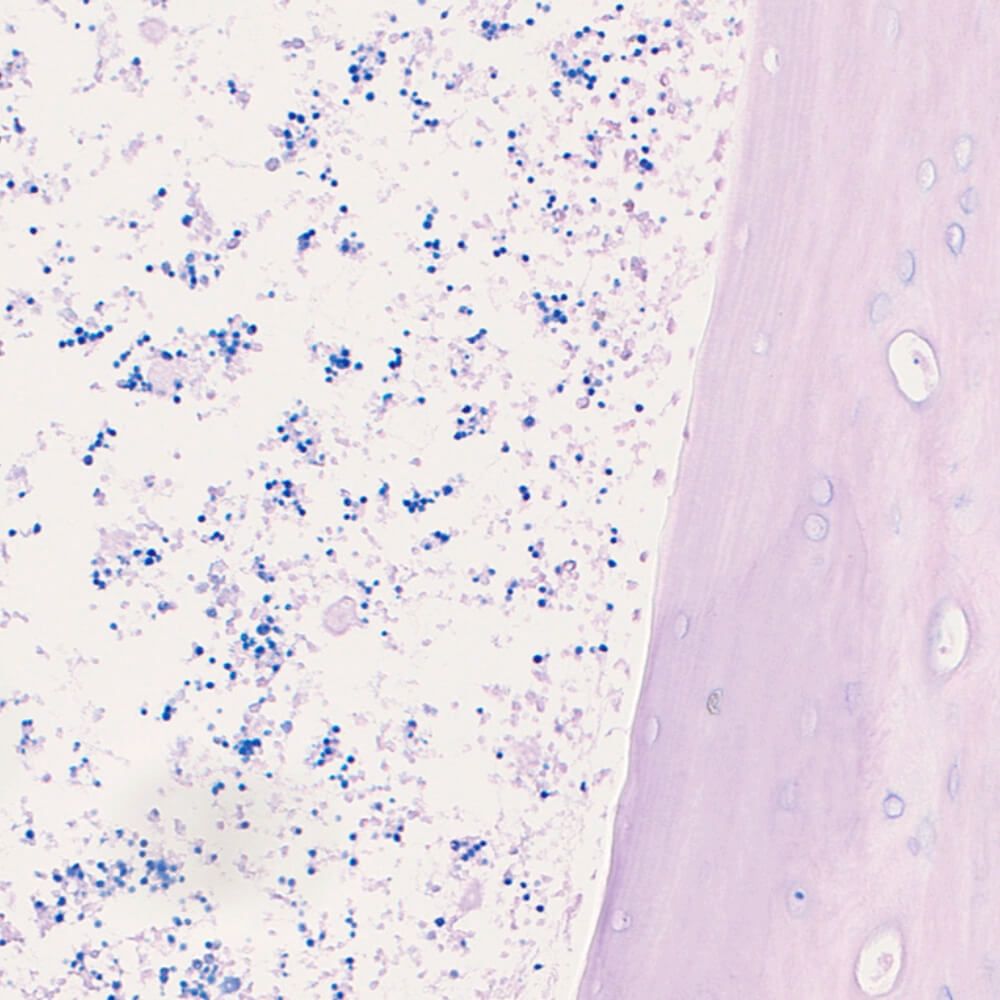
Giemsa
This stain is often used to stain blood (blood smears) or bone marrow.
Results: The nuclei will be stained a dark blue-violet, the erythrocytes a pale pink and the cytoplasm a pale blue.
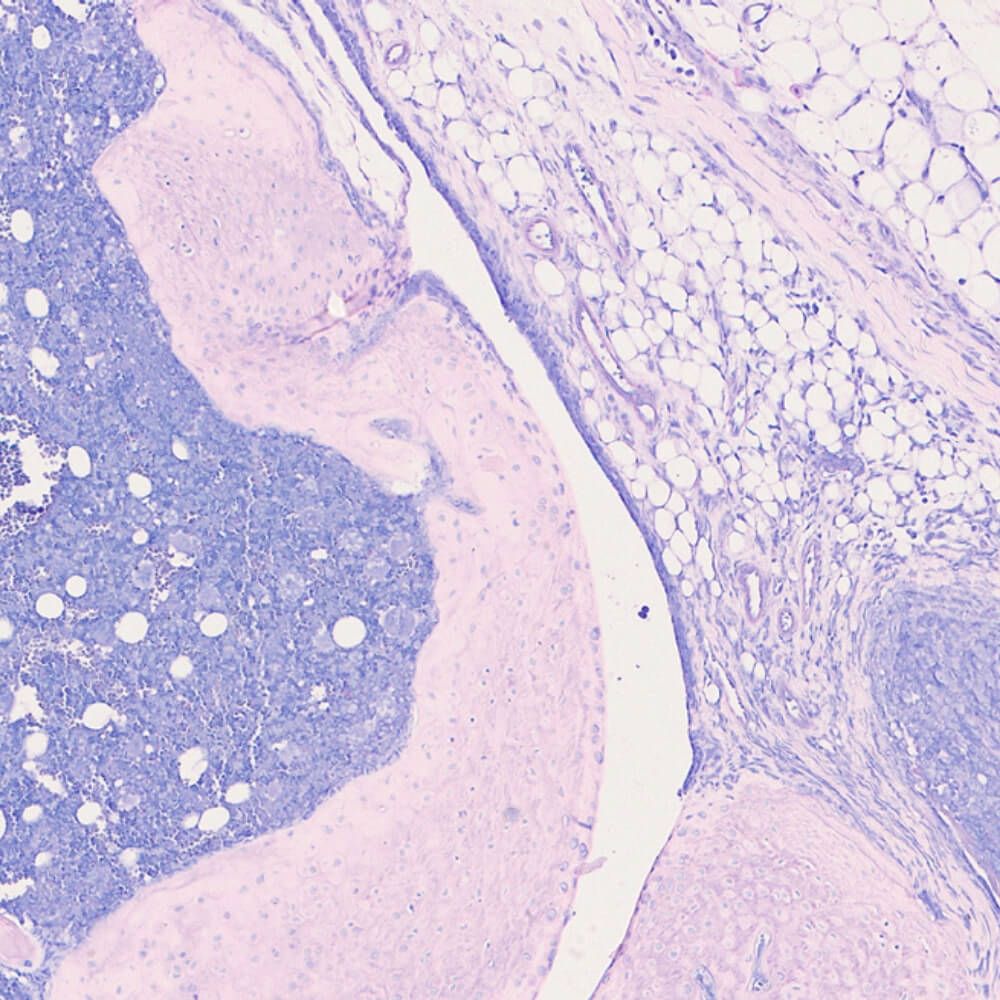
Wright-Giemsa
Used to stain blood smears or bone marrow samples. Can also be used to assess blood parasites. Wright is used as a counterstain to better visualize the Giemsa staining.
Results: Will stain nucleus, RNA, and other acidic components blue-purple, stain other components red-orange and the cytoplasm orange-pink.
Microorganism (Fungus & Bacteria) Stains
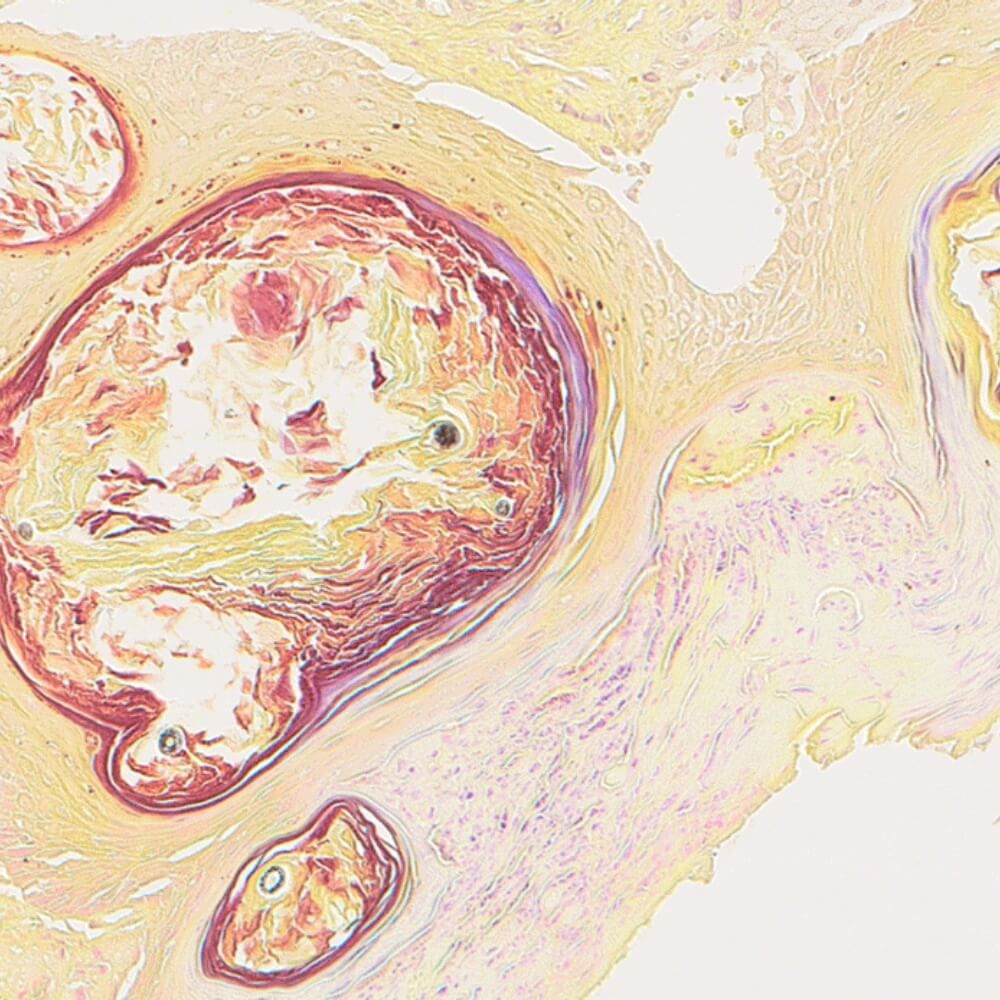
Gram
Gram staining checks for bacterial infection within tissues. Can be used in many tissues such as skin, through or lungs.
Results: Will stain gram positive bacteria purple, and gram-negative bacteria a pink or red.
Grocott
Grocott staining can be used to stain the basement membrane or different microorganisms like fungi
and pathogens.
Results: Will stain glycogen, bacteria, fungi, and basal membranes black, with the background
staining green.
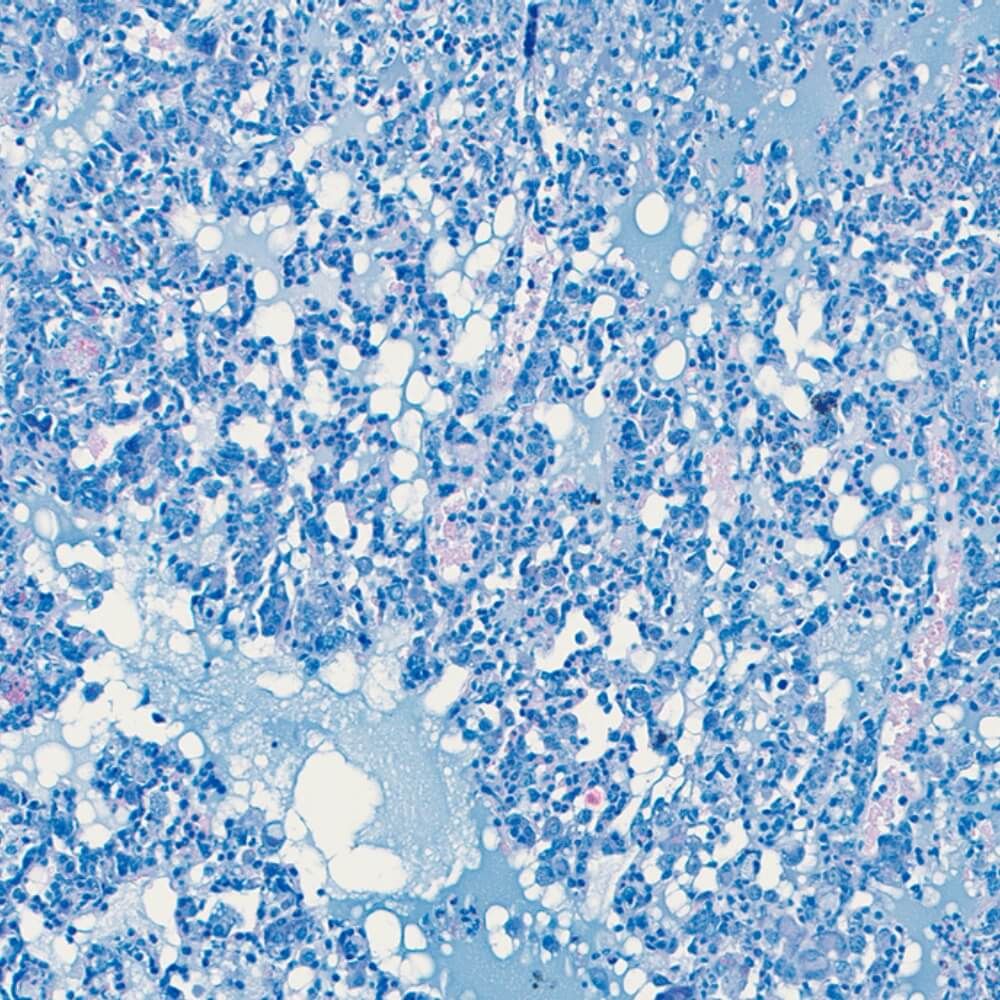
Ziehl-Neelsen (ZN)
ZN is used to stain Acid-Alcoholic Resistant Bacilli (AARB). The stain can be used in tissues where the mycobacteria may be present. ZN staining can also be used to assess diseases such as leprosy or tuberculosis.
Results: The stain will turn the AARB red, and the background blue.
Chromatin Stain
Nuclear Fast Red
Nuclear Fast Red is used to stain nuclear chromatin. Is often used as a counterstain in combination with other stains.
Results: Will stain chromatin red and stain background tissue pink.
Senescence Stain
Beta Gal
Beta Gal is used to stain aging or senescent cells. This stain can be used in any tissue or cell type. Often used on frozen tissue.
Results: Will stain sites where the Beta Galactosidase enzyme is active (senescent or aging cells) blue green. If nuclear fast red counter stain is used, will stain nuclei pink.
Amyloid Stain
Congo Red
Congo Red is used to stain amyloid within tissues. The stain can be used to see the presence of amyloidosis. It can also be used to stain bacteria- specifically virulent serotype 2a Shigella flexneri. Thicker sections (8-10 microns) should be used for staining.
Results: Amyloid deposits will stain a salmon colour or bright red, while background tissue will remain light pink, nuclei will stain blue.

